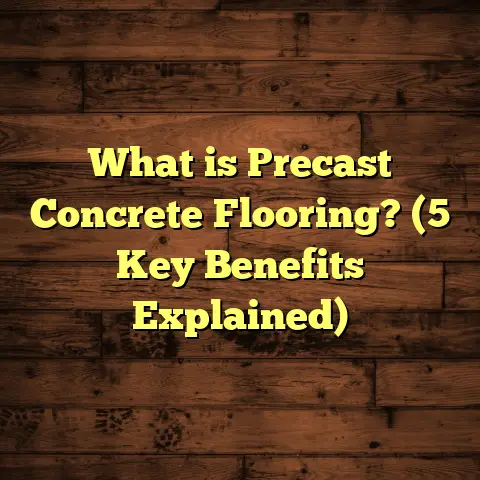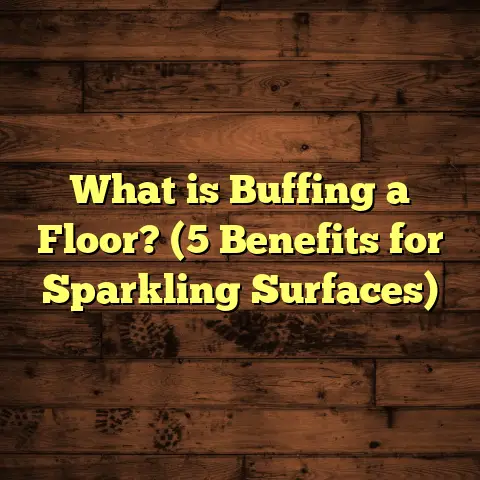What is an Acceptable Floor for a Small Porch Landing? (5 Key Guidelines)
Standing on a small porch landing is a bit like stepping onto a stage for your home’s welcome act. That little area sets the tone, invites guests in, and holds up to the elements every day. Choosing the right floor for this space is more than picking something that looks good. It has to work hard—handle weather, resist wear, and keep you safe. So, what makes a floor acceptable for a small porch landing? Let me share what I’ve learned from years of installing and testing different materials, plus some solid facts you might find useful.
What Is an Acceptable Floor for a Small Porch Landing?
An acceptable floor for a small porch landing is one that balances durability, slip resistance, weather resistance, aesthetics, and maintenance ease. This small patch of flooring is exposed to outdoor conditions but also acts as an entry point into your home, meaning it must withstand moisture, temperature changes, and foot traffic without losing its charm or safety.
In simple terms, it’s a floor that performs well under pressure—rain, snow, dirt, heavy boots, and casual footwear—while still looking inviting. It should protect the porch structure, avoid becoming slippery when wet, and fit the style of your home. I’ve seen many projects where ignoring one of these aspects led to costly repairs or unsafe conditions.
The porch landing isn’t just a step up to your front door—it’s the first impression visitors get. So, it has to be sturdy and welcoming. You want a floor that won’t warp or crack after one winter or become dangerous after a little rain.
Defining The Role of a Small Porch Landing Floor
Think about what this floor does day-to-day: it supports people stepping into your home carrying groceries, kids running in and out, pets leaving muddy paw prints. It also handles weather—rainwater dripping from umbrellas, snow melting off boots, UV rays beating down in summer.
Because of this constant stress and exposure, the flooring must be designed or chosen with these challenges in mind. It should provide:
- Traction to prevent slips
- Durability to withstand foot traffic and weather
- Weatherproofing to resist moisture damage
- Maintenance simplicity so upkeep doesn’t become overwhelming
- Aesthetic appeal that matches or enhances your home’s exterior look
I’ve encountered many homeowners who were surprised by how quickly their porch floor degraded because they picked materials better suited for indoor use or neglected installation details.
1. Prioritize Slip Resistance—Safety First
When you think of a porch landing, how often does it get wet? Rain, melting snow, or even morning dew can make that surface dangerously slippery.
Slip resistance isn’t just about preventing minor slips; it’s about avoiding serious injuries. According to the U.S. Centers for Disease Control and Prevention (CDC), falls are the leading cause of injury-related death among adults aged 65 and older. Your porch landing is one of the most common places where falls happen at home.
Why Is Slip Resistance Crucial?
If your porch is slick when wet or icy in winter, it becomes a hazard zone. I’ve been called out on emergency repairs after homeowners had guests slip and fall near their doorsteps.
Choosing materials with good traction is key. Here’s what I look for:
- Textured surfaces: Materials like textured concrete or stone pavers with rough finishes reduce slipping.
- Non-slip coatings: Applying anti-slip sealants or strips can improve grip on otherwise smooth materials.
- Grooved wood planks: For wooden porches, grooved or rough-sawn boards offer better footing than smooth decking.
Personal Story: The Slippery Wood Landing
Early in my career, I installed a beautiful mahogany porch landing with a high-gloss finish for a client who loved its look. It was stunning—until winter hit. The floor became slick with frost overnight. The homeowner called me after their mother slipped trying to come inside.
I recommended adding textured anti-slip strips and switching future clients toward less polished finishes. That incident shaped how I approach slip resistance in every project now.
Data Point: Slip Reduction Statistics
Research from the American Society of Safety Professionals shows textured surfaces can reduce slips by up to 50% compared to smooth floors when wet.
Even small interventions like adding rubber-backed mats designed for outdoor use near the door can help but aren’t substitutes for choosing inherently slip-resistant flooring.
Materials Known for Good Slip Resistance:
| Material | Slip Resistance Level (Wet Conditions) |
|---|---|
| Textured Concrete | High |
| Porcelain Tile (Matte/ Textured) | Medium to High |
| Composite Decking (Grooved) | Medium |
| Rough-Sawn Hardwood | Medium |
| Smooth Stone (Polished) | Low |
When selecting materials, ask your supplier about slip ratings or look for certifications such as ASTM F1677-13 (Standard Test Method for Using a Portable Inclineable Articulated Strut Slip Tester).
2. Choose Weather-Resistant Materials
Porch landings face the full force of weather exposure—sun, rain, snow, and temperature swings. Some materials absorb water and warp or crack; others fade under UV rays.
I’ve tested various materials over years and found that composite decking, porcelain tiles, and pressure-treated woods hold up best in outdoor conditions.
Why Weather Resistance Is Non-Negotiable
Moisture penetration leads to rot in wood floors unless they’re properly treated or maintained. Freeze-thaw cycles can crack tiles that aren’t rated for outdoor use.
Sun exposure causes fading and surface degradation in many materials. Remember that porch landings are usually uncovered or only partially sheltered—UV protection matters.
Common Weather Challenges:
- Water damage: Causes swelling, warping, mold.
- UV damage: Fades color and weakens material.
- Freeze-thaw damage: Cracks tiles or concrete.
- Thermal expansion: Can warp wood or loosen boards.
Materials That Handle Weather Best:
| Material | Weather Resistance Features | Expected Lifespan* |
|---|---|---|
| Composite Decking | UV stabilized, waterproof core | 25+ years |
| Porcelain Tiles | Frost resistant, dense | 20+ years |
| Pressure-treated Wood | Treated against rot and insects | 10-15 years (with maintenance) |
| Natural Stone | Durable but porous unless sealed | 20+ years (sealing required) |
| Vinyl Outdoor Flooring | Waterproof but varies by product | 8-12 years |
*Lifespan depends on installation quality and maintenance.
In one project for a coastal home exposed to salty air and heavy rain, untreated wood failed within two years due to rot and insect damage. Switching to composite decking designed for marine environments saved the homeowner from repeated repairs.
Tips for Weatherproofing Porch Landings
- Seal wood annually with high-quality waterproof sealants.
- Use frost-rated tiles specifically made for outdoor use.
- Ensure proper drainage so water doesn’t pool.
- Consider a roof or awning if feasible to reduce direct exposure.
3. Installation Matters—Get It Right
Even the best materials fail if installed poorly. A porch landing typically needs proper drainage to avoid puddles forming on the surface.
I’ve learned that installation can make or break your porch landing’s longevity and safety.
Key Installation Steps I Follow:
- Slope the floor: At least 1/4 inch per foot away from the house to direct water runoff.
- Secure fasteners: Use stainless steel or coated screws that resist rust.
- Prepare subfloor: Ensure it’s stable and moisture-resistant—concrete slabs are ideal bases.
- Seal joints thoroughly: Prevent water infiltration between boards or tiles.
Why Slope Is Critical
Without slope, water pools can form on your porch landing’s surface. Standing water accelerates wear and invites algae growth—a slippery mess.
Once I fixed a client’s porch where poor slope caused puddling and slippery moss buildup every spring. We had to remove and re-lay boards with corrected slope—costly but necessary.
Fastener Recommendations
Using galvanized or stainless steel screws prevents rust stains on visible surfaces and keeps boards tightly fixed over time.
Nails may pop up under temperature changes; screws hold better but require pre-drilling.
Subfloor Preparation
If you’re installing tile on a porch landing, the underlying concrete slab must be sound without cracks or moisture seepage issues.
For wood decks over joists, make sure airflow underneath prevents moisture buildup which leads to rot.
4. Maintenance Should Be Manageable
Some floors demand too much upkeep for an outdoor setting. If your porch landing becomes a chore every month, you might ignore maintenance until problems arise.
I always ask clients: “How much time do you want to spend maintaining this area?” Their answers shape my recommendations.
Wood Floors Need Regular Care
Hardwood porches are beautiful but require sealing every 1–3 years depending on exposure. That means sanding worn spots and applying protective oils or sealers to prevent rot and UV damage.
If you skip this step regularly, expect fading, splintering, and eventual replacement within 5–7 years.
Composite Decking Is Low Maintenance
Composite materials usually just need occasional cleaning with soap and water. No sanding or sealing required.
This makes them popular among busy homeowners who want durable floors without hassle.
Porcelain Tiles Require Minimal Upkeep
Outdoor-rated porcelain tiles resist stains and moisture well but grout lines may need cleaning yearly to prevent mold buildup.
Sealing grout helps but isn’t mandatory if you pick epoxy grout options designed for outdoors.
Personal Experience With Maintenance Choices
For a family with young kids and pets, we chose composite decking. The parents loved not having to apply sealants or worry about splinters.
For another client focused on traditional aesthetics willing to maintain regularly, I installed stained cedar planks with annual resealing plans.
The point? Maintenance preferences should influence your material selection as much as other factors.
5. Match Your Style Without Sacrificing Function
Porch landings are part of your home’s curb appeal. You want something that fits your home’s design but also meets practical needs.
I often recommend blending style with durability—like using natural stone tiles with textured surfaces or warm-toned composite decking that mimics real wood grain.
Style Meets Practicality
I remember working with a homeowner who adored red brick porches but worried about slipperiness when wet. We chose textured pavers with similar color tones providing grip plus classic charm.
Others prefer sleek modern looks—textured porcelain tiles in neutral shades can fit that style without sacrificing safety or weather resistance.
Matching Style With Budget
Porch flooring budgets vary widely:
- Budget range $500-$1,000: Concrete with stamped textures or basic pavers.
- Mid-range $1,000-$3,000: Composite decking or high-quality tile.
- Premium $3,000+: Natural stone like slate or granite with professional installation.
I always remind clients style doesn’t have to break the bank if you plan carefully and pick materials smartly based on priorities.
Additional Insights From My Experience
How Much Does Porch Landing Flooring Cost?
Based on recent project data:
| Material | Average Cost Per Sq Ft (Material + Installation) |
|---|---|
| Concrete (Stamped) | $8 – $12 |
| Composite Decking | $15 – $25 |
| Porcelain Tile | $12 – $20 |
| Pressure-treated Wood | $10 – $15 |
| Natural Stone | $20 – $35 |
Costs vary by region and complexity but expect higher labor costs for tile due to precise installation requirements.
How Large Are Small Porch Landings Typically?
Most small porch landings range from 15 to 50 square feet—about enough space for two people standing comfortably side-by-side.
This size means material choice impacts final cost directly since smaller spaces can sometimes justify higher-end finishes without breaking budgets severely.
Common Problems I See On Porch Landings
- Water pooling due to poor slope
- Slippery surfaces causing falls
- Wood rot from neglected sealing
- Cracked tiles from improper base prep
- Faded colors from sun exposure
- Loose boards creating tripping hazards
Addressing these issues upfront by following proper guidelines avoids headaches later on.
Case Study: From Disaster to Delight — A Porch Landing Makeover
A couple contacted me after their small front porch landing deteriorated badly within two years post-construction. The previous installer had used untreated pine boards with no slope or sealing applied. Water pooled near the door causing rot; boards warped; paint peeled off; moss grew making it slippery; guests nearly slipped several times.
We reworked the floor using composite decking with built-in UV protection and anti-slip texture. The substructure was repaired with treated lumber; proper slope was created; flashing installed to divert water away from the house foundation; all screws were stainless steel. The result: a durable porch landing that maintained its beauty through heavy rains and snowy winters without extra maintenance demands on the owners.
The couple was thrilled — no more slipperiness or rot worries — and got compliments from neighbors noticing their fresh new look.
Frequently Asked Questions About Porch Landing Floors
Q: Can I install hardwood flooring on an uncovered porch landing?
A: Generally not recommended unless it’s pressure-treated hardwood with proper sealing applied regularly. Untreated hardwood warps quickly when exposed directly to elements.
Q: How often should I reseal my wood porch landing?
A: Every 1–3 years depending on climate exposure and sealer type used. Watch for signs like fading color or water absorption indicating resealing need.
Q: Are composite decks slippery when wet?
A: Most composite decking includes textured surfaces reducing slipperiness significantly compared to smooth wood finishes.
Q: Can I paint my porch landing floor instead of using other materials?
A: Painting concrete floors is common but requires specific outdoor-grade paints designed for traction. Paint chips over time so expect maintenance every few years.
Q: What’s the best way to clean an outdoor tile porch?
A: Use mild detergent with water plus soft-bristle brushes to clean dirt from grout lines gently once or twice yearly.
Final Thoughts From My Workshop
Choosing an acceptable floor for your small porch landing involves weighing safety features like slip resistance alongside weather durability and maintenance effort—all while matching your home’s style and budget preferences.
From my experience installing many porch floors across seasons and climates:
- Don’t sacrifice safety for looks alone.
- Pick weatherproof materials suited for your local climate.
- Invest in proper installation including slope and sealing.
- Choose maintenance levels you can realistically handle.
- Blend style choices with functional performance for lasting satisfaction.
Your porch landing is more than just a threshold—it’s where guests first step into your home story. Designing it thoughtfully pays off in comfort, safety, beauty, and peace of mind year after year.
If you want advice tailored specifically for your porch project—drop me a line anytime! I’m happy to share detailed recommendations based on your unique needs so your small porch landing stands strong through all seasons without hassle.





